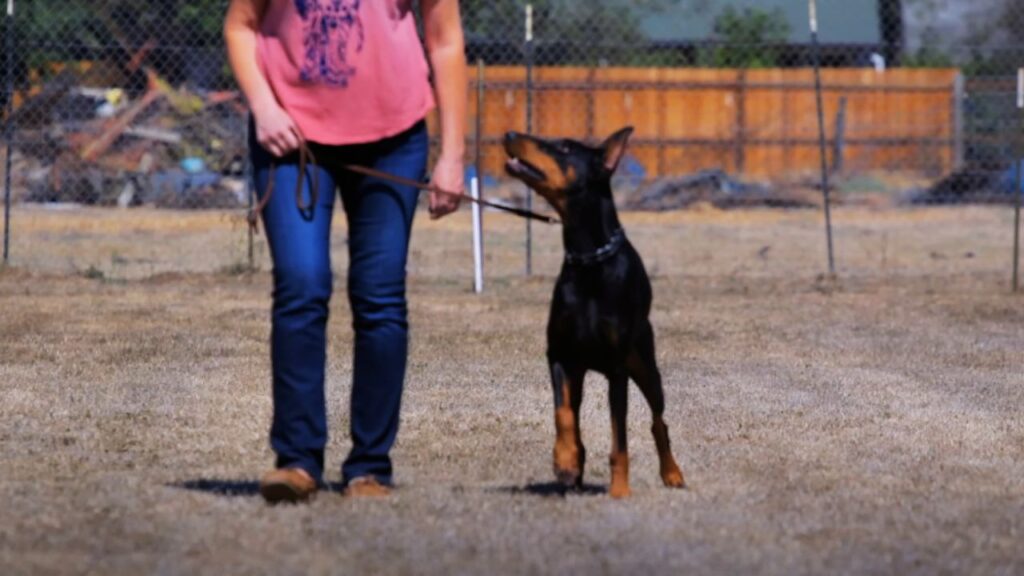Dobermanns are renowned for their sleek appearance, athletic build, and intelligent, protective nature. These highly active and loyal dogs are often employed as guard dogs, companions, and even in search-and-rescue operations. Given their strength and energetic nature, collars are essential for managing and training them properly. However, choosing the right collar and fitting it correctly can make a significant difference in both your dog’s comfort and behavior. So, how to put collars on Dobermann?
For the best guidance on selecting the right collar size for your Dobermann, check out this detailed article on what size collar is best for Dobermann, which offers valuable insights into measurements and fitting tips.
In this comprehensive guide, we will cover the types of collars suitable for Dobermanns, how to fit them properly, and some practical tips for introducing collars safely. We’ll also share key insights and numeric data to ensure you make informed decisions. For step-by-step instructions on properly fitting a collar on your Bedlington Terrier, visit this comprehensive guide on how to put collars on Bedlington Terrier.
Blog Highlights
ToggleQuick FAQs: How to Put Collars on Dobermanns
Why Does Your Dobermann Need a Collar?
Collars are not just accessories—they serve critical functions in your dog’s daily life and safety. Here are a few important reasons why your Dobermann should wear a collar:

- Control During Walks: Dobermanns are muscular and energetic dogs that can be challenging to control, especially during outdoor activities.
- Training and Behavior Management: Collars are essential tools in behavior training, helping to reinforce good behavior and correct unwanted actions.
- Identification and Safety: Having an ID tag attached to the collar ensures that if your dog gets lost, it can be returned to you quickly.
- Legal Requirements: Many regions require dogs to wear collars with tags showing the owner’s contact information and rabies vaccination records.
Without a properly fitted collar, you may struggle to manage your Dobermann, and your pet could also experience discomfort or even injury. The type and fit of the collar play a significant role in achieving both safety and training goals.
To learn about the ideal collar size for your Bedlington Terrier, including measuring tips and size recommendations, check out this detailed guide on what size collar is best for Bedlington Terrier.
Types of Collars Suitable for Dobermanns
Choosing the right collar can enhance both the training process and your dog’s comfort. Here are the most suitable types of collars for Dobermanns, each with specific use cases.
1. Flat Collars: Everyday Wear
A flat collar is the most common type, ideal for general use. These collars are simple, lightweight, and adjustable, making them suitable for daily wear.

- Materials: Typically made from nylon, leather, or fabric.
- Size Recommendation: 14-22 inches long for an adult Dobermann, depending on the size of your dog’s neck.
- Purpose: Ideal for carrying ID tags and for leash attachment during casual walks.
Pro Tip: Use the two-finger rule to ensure the flat collar is snug but not too tight. If two fingers can fit comfortably between the collar and your dog’s neck, the collar is adjusted correctly.
2. Martingale Collars: For Training and Control
A Martingale collar tightens slightly when your dog pulls, preventing it from slipping out without choking the dog. These collars are especially effective for Dobermanns, as they are prone to slipping out of regular flat collars.

- Materials: Usually a combination of nylon and chain.
- Size Range: 16-24 inches, adjustable to fit snugly around the dog’s neck.
- Use Case: Recommended for leash training and dogs with narrow heads, like Dobermanns.
Numeric Insight: Martingale collars tighten by 1-2 inches when the dog pulls, providing control without causing discomfort. This feature makes them a popular choice for dogs that need gentle correction during walks. For detailed guidance on ensuring the perfect collar fit for your St. Bernard, check out the Best Practices for St. Bernard Collar Adjustment to keep your dog comfortable and secure.
3. Prong Collars: For Specialized Training
Prong collars are controversial but can be useful for advanced training when used correctly. These collars consist of metal links with blunt prongs that apply pressure evenly around the dog’s neck.

- Size Recommendation: 16-18 inches for Dobermanns, with adjustable links for a custom fit.
- Purpose: Used for behavior correction during supervised training.
Warning: Prong collars must be used cautiously and under expert guidance to avoid injury. They should only be used temporarily and never left on your dog unsupervised.
4. Harnesses: An Alternative to Collars
Some owners prefer harnesses, especially if their Dobermann pulls excessively on the leash. Harnesses distribute pressure evenly across the chest and back, reducing strain on the neck.

- Use Case: Recommended for dogs with respiratory issues or for those in the early stages of leash training.
- Tip: If you use a harness, keep a flat collar with an ID tag on your dog as well, for identification purposes.
How to Measure Your Dobermann for a Collar
A well-fitted collar is essential to ensure your Dobermann’s comfort and safety. Here’s how to measure your dog accurately:

- Use a Soft Tape Measure: Measure around the thickest part of the neck, which is usually at the base, just above the shoulders.
- Add Two Inches: This ensures the collar won’t be too tight, allowing enough room for comfortable movement.
- Test the Fit: Once the collar is on, you should be able to fit two fingers between the collar and your dog’s neck.
Example Measurements:
- Puppies: 12-16 inches
- Adult Males: 16-20 inches
- Adult Females: 14-18 inches
Ensure your Newfoundland’s comfort and security with expert tips on how to ensure a safe collar fit for Newfoundland.
Step-by-Step Guide: How to Put Collars on Dobermann
Here’s a detailed, step-by-step guide to ensure you put a collar on your Dobermann correctly and comfortably:
Step 1: Choose the Right Collar
Select a collar that matches your dog’s needs—flat collars for daily use, Martingale collars for training, or a prong collar if specialized training is required.

Step 2: Introduce the Collar Gradually
Let your Dobermann sniff and examine the collar before putting it on. This helps reduce anxiety, especially for puppies or dogs not used to collars.
Pro Tip: Offer a treat or verbal praise during this process to create positive associations.

Step 3: Place the Collar on Your Dog
Gently place the collar around your dog’s neck, positioning it at the base of the neck. Make sure it is not placed too high near the throat, as this can cause discomfort.

Step 4: Adjust the Fit
Tighten the collar so it fits snugly but does not choke. Use the two-finger rule to check for proper fit—two fingers should slide easily between the collar and your dog’s neck.

Step 5: Observe Your Dog’s Behavior
After putting on the collar, monitor your Dobermann to see if it shows signs of discomfort, such as scratching at the collar or trying to remove it. If needed, readjust the fit.

Discover the ideal fit by learning what size collar for Newfoundland dog to ensure your pet’s comfort and safety.
Common Mistakes to Avoid
- Using a Collar That’s Too Tight: This can cause chafing, breathing difficulties, and discomfort.
- Leaving the Collar On 24/7: Removing the collar when indoors helps prevent skin irritation and hair matting.
- Ignoring Size Adjustments: Dobermanns grow rapidly during the first year, so collars must be adjusted frequently to ensure a proper fit.
- Using Prong Collars Improperly: These collars can cause injury if used incorrectly or without supervision.
- Failing to Replace Damaged Collars: Worn-out collars with frayed edges or broken buckles can be dangerous.
Safety Tips for Using Collars on Dobermanns
- Use Breakaway Collars for Puppies: These collars release under pressure, preventing choking if the collar gets snagged.
- Inspect Collars Regularly: Look for signs of wear and replace collars when needed to avoid accidents.
- Attach an ID Tag: Ensure your dog’s collar has an ID tag with up-to-date contact information.
- Avoid Constant Chaining: Chaining Dobermanns for long periods can lead to behavioral problems and frustration.
- Consider Microchipping: In addition to a collar, microchipping provides a backup identification method in case your dog loses its collar.
Key Insights and Statistics
- Average Collar Size for Adult Dobermanns: 16-22 inches
- Frequency of Collar Adjustments: Every 2-3 weeks for puppies and every few months for adult dogs
- Training Success with Martingale Collars: 60-70% of owners report improved leash behavior within 2-3 weeks
- Lost Dogs with ID Tags: Dogs with ID tags are 38% more likely to be returned to their owners.
Behavioral Impact of Wearing the Right Collar
The type and fit of the collar you choose for your Dobermann can have a significant impact on their behavior, both during walks and at home. Dobermanns are known for their intelligence and sensitivity, meaning they respond well to training but can also become stressed if not handled correctly.
1. Positive Reinforcement with Proper Collars
Using collars like Martingale collars helps you reinforce good leash behavior through gentle correction. With the proper use of these collars, many owners report that their Dobermanns show improvements within a few weeks. Dobermanns respond particularly well to consistency, and a well-fitted collar helps signal appropriate behaviors while reducing the chance of frustration.
For expert tips on how to fit a collar on a Belgian Shepherd, this guide offers simple steps to ensure your dog’s collar fits securely and comfortably.
2. Reducing Anxiety Through Familiarity
Introducing the collar early and gradually helps reduce anxiety. Puppies, in particular, benefit from wearing lightweight collars from a young age to get accustomed to the sensation. This familiarity helps them remain calm during outdoor activities and future vet visits.
3. Preventing Behavioral Issues
Without proper control, Dobermanns can develop negative behaviors like leash-pulling or lunging. Prong collars, when used under expert guidance, offer corrective feedback for such issues. However, relying solely on physical correction without positive reinforcement can lead to fear and anxiety, which is why balance is key to training success.
Conclusion
Putting a collar on a Dobermann may seem like a simple task, but it requires thoughtful consideration and proper technique. Choosing the right collar, ensuring a proper fit, and introducing it gradually will enhance both your dog’s comfort and training experience. Whether you opt for a flat collar for daily use, a Martingale collar for training, or a prong collar for specialized correction, the key is to use these tools responsibly and safely.
Regular adjustments and inspections are essential, especially for growing puppies or active adult dogs. With the right approach, your Dobermann will feel comfortable, secure, and well-behaved, making every walk and training session a positive experience. Hope so, now you know how to put collars on Dobermann?
Do you have experience putting collars on your Dobermann? Share your thoughts and tips in the comments below!
For detailed guidance on selecting the correct collar size for a Belgian Shepherd, this article provides essential tips to ensure your dog’s comfort and safety.





